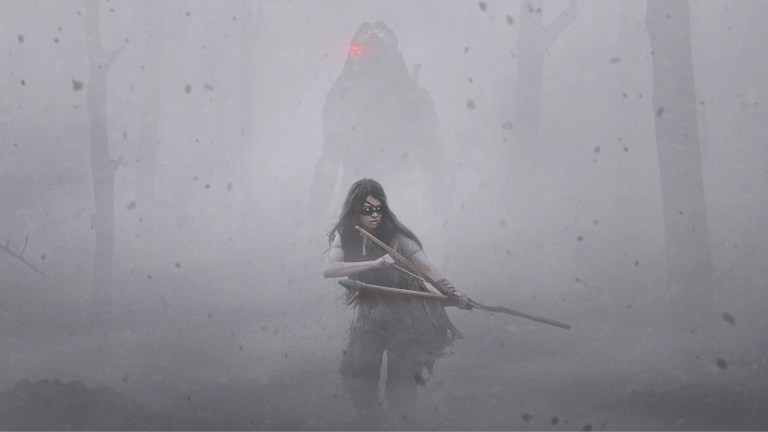Prey Post-Credits Scene Moment Makes You Read Between the Lines
Prey has a post-credits scene of sorts, and what it means is VERY intriguing.

This article contains Prey spoilers.
Who knew the secret to the Predator franchise’s future was to always go back in time? It seems director Dan Trachtenberg did! This weekend’s Prey is the culmination of years of passion, and years of planning, from the filmmaker who wrested the Predator movies away from their recent and failed experiments of franchise-building in the future. Instead the new movie finds a simple and potent blend of historical fiction and sci-fi fantasy when one of those aliens from above decides to go hunting on Comanche lands during the early 1700s.
It’s there we find the first good protagonist in this franchise since Arnold Schwarzenegger in 1987. But Amber Midthunder’s Naru is neither an Austrian Übermensch or a great warrior (yet) among her people. Rather she is a young woman determined to prove she is the latter, including to her older brother Taabe (Dakota Beavers). In the end, she does Taabe one better by killing a Predator (Dane DiLiegro) all by herself.
She ultimately traps the invasive species—who looks all the more sinister in a movie that also features French fur trappers eager to mow down Indigenous people—in a mud pit, causing him to sink to his neck before shooting himself in the face. It’s so gratifying. It also is a nice reversal of how Schwarzenegger’s Dutch hid from his own Predator in the original movie.
At first glance, this appears to be the end of Naru’s story. Unlike the rest of her tribe, she has been able to put this monster from the stars in the ground, permanently, and returns home with the creature’s head dripping glorious, neon green blood. If you turned the movie off after the credits began, you’d think that is the end of the story; Naru proved herself a true warrior and her Comanche people were free of intergalactic colonizers… however there is more to the story if you paid close attention to the end credits…
The Prey Post-Credits ‘Scene’
The “post-credits scene” in Prey is technically neither after the credits or a full scene. Rather it’s a cheeky and monumental sequence which teases a real scene of horror and bloodshed midway through the ending scrawl.
When the end text starts rolling in Prey, we are treated to one of those nice and expensive looking animated sequences that have become all the fashion in the last decade. It’s practically the only variation of a credit sequence that Marvel Studios will entertain these days. Yet there’s something cleverer and more mischievous at play here. Intentionally meant to emulate the type of ledger art practiced by Plains Indian communities, including the Cheyenne, Kiowa, and Comanche, among others, the credits sequence is designed to tell in sketch art the story of the movie you just watched.
In essence, the animated sequence suggests that Naru’s victory over the Predator became the stuff of legend and oral tradition: a story that was passed down from one generation to the next, including eventually on ledger paper. And as we approach the end of its above the line credits—for 20th Century Studios and Hulu—we see the climactic moments of Prey’s story reenacted: Naru kills the Predator with the help of her mighty dog and carries his emerald-kissed head back to her people who rejoice.
… It then keeps going. The Comanche’s celebration is cut short as ominous storm clouds roll in from the heavens—and multiple alien ships (at least three?) appear in the sky, promising a continued invasion and multiple Predators.
This animated sequence obviously teases the story is not over. At most, we’ve reached a kind of intermission before the real test comes when the Predators return to Comanche lands in force. What happens next? Well, presumably we’d need another movie to find out.
The good news is that the fact the story we just saw has presumably been passed down through the generations suggests that some of our lovable protagonists survive. And yet, it’s chilling to think what a potential army of Predators can do after we saw them massacre an entire French village’s worth of fur trappers earlier in the movie. And given how the lone Predator in Prey can be viewed as a metaphor for European incursions into this land… it’s an ominous note for the future of Naru and her people.
Hopefully though audiences respond as warmly to Prey as critics have, which would ensure we find out what happens after the invaders come back.
Prey is streaming on Hulu now.
